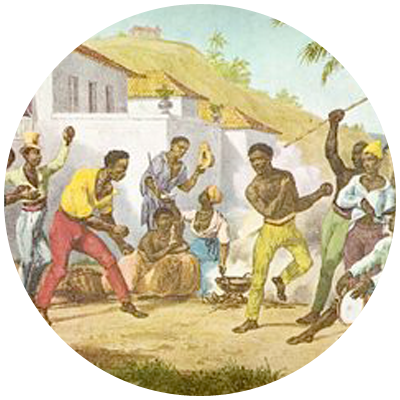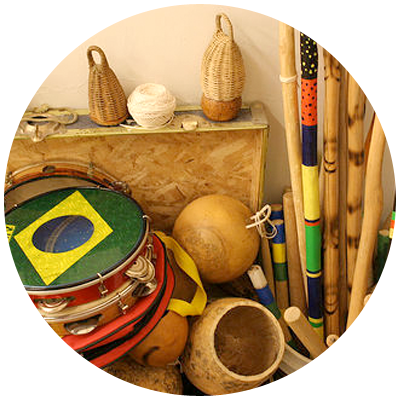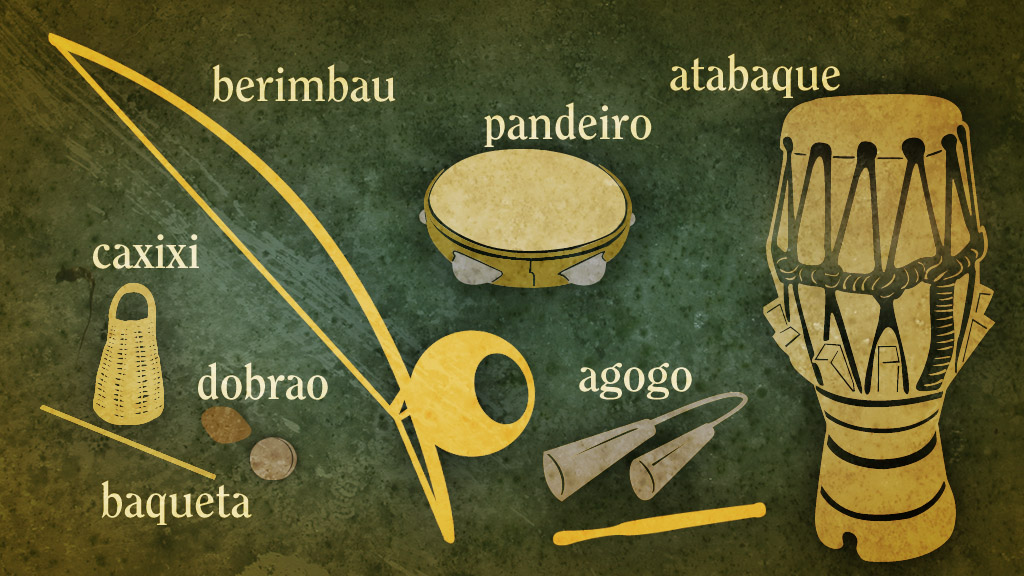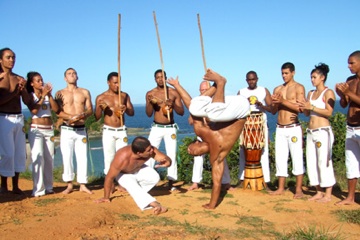
Capoeira is an Afro-Brazilian martial art developed in the 1500s by African and Indigenous slaves in Brazil as a form of self-defence from their oppressors. It is marked by its agile and tricky movements that may be executed anywhere from an upside-down position, to a gravity defying kick. It has a strong acrobatic component in some styles and is always played with music.
The word Capoeira is an indigenous word meaning tall grass. If slaves managed to escape, they would often use this grass to hide in and ambush their masters. At its purest level, Capoeira simply becomes a conversation between two bodies in motion, and at this level it truly becomes a sight to behold. The music controls the focus of the game, and from the music the movements of Capoeira flow. The berimbau leads the “roda” (circle) and dictates the type of “jogo” (game) that the two “capoeiristas” (people who play capoeira) must play. They, and everyone else playing in the roda must essentially follow the rhythm of the berimbau. The jogo is played inside the roda with the instruments positioned at the top. The musicians and instruments are the focal point of the roda and all play begins from the area in front of the musicians.
There are two main styles of Capoeira, along with many other less distinct ones. One is called Angola, which is characterized by tricky, low play with particular attention to the rituals and tradition of Capoeira. This style is often described as slow, however, may be just as fast as the next style, but with different rituals. The other style is Regional, known for its fluid acrobatic, high-flying kicks and powerful attacks. Speed and agility are common traits of this style. Both styles of Capoeira are marked by counter attacks, feints, and use lots of ground movements along with elbows, hands, kicks, head-butts,sweep and other take-downs.
The word Capoeira is an indigenous word meaning tall grass. If slaves managed to escape, they would often use this grass to hide in and ambush their masters.
Music in Capoeira

Music is integral to Capoeira. It sets the tempo and style of game that is to be played within the Roda. The music is comprised of instruments and songs. The tempos differ from very slow to very fast. Many of the songs are sung in a call and response format (quadras and corridos) while others are in the form of a narrative (chula or ladainha). Capoeiristas sing about a wide variety of subjects. Some songs are about history or stories of famous capoeiristas. Other songs attempt to inspire players to play better. Some songs are about what is going on within the roda, or a personal challenge from one Capoeirista to another. Sometimes the songs are about life, or lost love. Others are lighthearted or even silly things, sung just for fun. Capoeiristas change their playing style significantly as the songs or rhythm from the Berimbau commands. In this manner, it is truly the music that drives capoeira.
There are three basic kinds of songs in Capoeira:
- Ladainhas (litany), which are narrative solo songs, usually sung at the beginning of a roda, often by the Mestre (a teacher). These ladainhas will often be famous songs previously written by a Mestre, or they may be improvised on the spot.
- Quadras, which are another form of narrative song that are broken down into into multiple verses.
- Corridos, which are songs that are sung while a game is being played, following the call and response pattern. The responses to each call do not simply repeat what was said, however, but change depending on the song.

The instruments are played in a row called the Bateria. The first three instruments are Berimbaus, which look like an archer's bow using a steel string and a gourd for resonation. These three Berimbaus are:
- Gunga (also called the Berraboi)
- Medio
- Viola (or Violinha)
Other instruments in the bateria are: Pandeiro (tambourines), and the Atabaque (conga-like drum). Sometimes an Agogo (cowbells) and a Reco-reco (rasp) are used, particularly in the Angola style of Capoeira.
The “Game” of Capoeira

Styles and Groups of Capoeira
There are many different kinds of capoeira. The two largest types are Angola and Regional. Although groups of one style do exist, most groups tend to mix the two styles to some degree. Capoeira Angola groups from the Northeast will tend to identify only as Capoeira Angola and will mimic Regional for performances. Angola is considered to be the true root style of Capoeira, often characterized by slower, sneakier movements played closer to the ground. Capoeira Angola, in actuality, is played in a great range of speeds, ranging from fast, highly acrobatic movements and frenetic high tempo music to much slower, methodical movements to low tempo, hypnotic music.
The father of modern Capoeira Angola is considered to be Mestre Pastinha who lived in Salvador, Bahia. Today, most of the Capoeira Angola media that is accessible comes from Mestres in Pastinha’s lineage, but this isn’t to say that he was the only one or that he was the originator. Many others helped in the preservation and propagation of Capoeira Angola, including Mestre Caicara, Mestre Bobo, Mestre Noronho, Besouro Manganga, etc. The Angola style, while emphasizing the traditions and history of Capoeira remains a contemporaneous art in the vibrant street scene of Salvador, Bahia. There is a diversity of styles and players, all of the traditional form, playing or performing in a great range of speeds and testing each other in various academies and in the street. Regional is a newer and more martially-oriented game.
Regional was developed by Mestre Bimba to make capoeira more mainstream and accessible to the public, and less associated with the criminal elements of Brazil. While Capoeristas can sometimes play Angola-like, slow games, the Regional style is most often composed of fast, acrobatic, and athletic play. This type of game is characterized by high jumps, acrobatics, and spinning kicks, while maintaining the trickiness and ground-work characteristic of Capoeira Angola. Today, there are many fusion styles, which mix the Angola and Regional traditions. Some refer to this as Capoeira Atual, or Capoeira Contemporanea.
Whether playing Angola or Regional, groups often have different styles of wildly different movements. In general, older groups/styles often have a greater emphasis on the traditions of Capoeira, while newer groups concentrate chiefly on sports-like technique. If you join a Capoeira group, you may eventually have a chance to take place in a batizado, a baptism into the art of Capoeira. At this point, you will normally be given a ‘corda’, a cord belt, as well as your ‘apelido’ or Capoeira nickname. Batizados are great celebrations of Capoeira, and normally a number of groups and masters from nearby or far away areas are invited to the celebration. These ceremonies are a great chance to see a variety of different Capoeira styles, to watch mestres play, and to see some of the best of the game. these celebrations are open to the public, and they are a great chance for outsiders to learn about the art. [source: Wikipedia]
Capoeira Contemporanea
